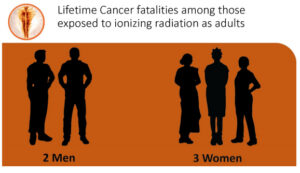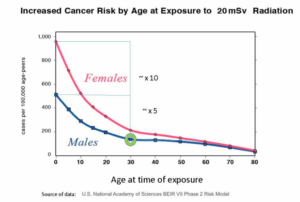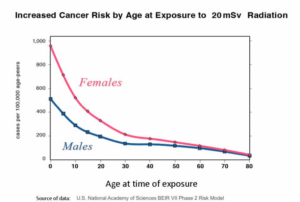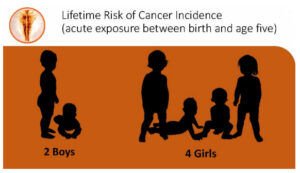
“Finding these patterns does not make them new. Ionizing radiation inflicts disproportionate harm to girls and women compared to boys and men, and the
difference is not trivial. It is time to update policy to protect everyone better.” – Mary Olson
“Reference Man” has been historically used for generic evaluation of ionizing radiation impacts, regulation, and nuclear licensing decisions made by the US Nuclear Regulatory Commission (US NRC 2018). Findings from sixty years of A-bomb survivor data show that Reference Man does not represent the human life cycle with respect to harm from radiation exposure. Findings reported here show females are more harmed by radiation, particularly when exposed as young girls, than is predicted by use of Reference Man; the difference is a much as ten-fold. Since females have been ignored in regulatory analysis, this has resulted in systematic under-reporting of harm from ionizing radiation exposure in the global population. A critique is also offered on the US Environmental Protection Agency’s attempt to include females in its regulation. Recommendations for interim regulation to provide better protection, and questions for further study are offered.
Introduction
This paper focuses on regulation in the United States, where agencies governing human exposure to ionizing radiation base health standards and rules on adult male tolerance. The study question here: Is biological sex and age a factor in outcome of radiation exposure? Long-term study of A-bomb survivors shows variability in rate of harm (cancer incidence) across the human life cycle. The findings reported here, supporting previous findings of Makhijani, Smith and Thorne (2006), show that age at exposure to radiation is a factor for both sexes, while harm to females is greater in all age-exposure groups.
The U.S. Nuclear Regulatory Commission (US NRC) evaluates radiation exposure, harm from exposure, and constructs radiation safety limits used for permits to allow exposure to workers and to the public. These limits are based solely on data from the external radiation exposure of adult males (U.S. Nuclear Regulatory Commission, 2018). By convention, radiation exposure calculations are performed with reference to a standardized hypothetical individual. At US NRC this is still Reference Man, as defined by the International Committee for Radiation Protection (ICRP). The definition specifies age, height, weight, race and ethnicity, lifestyle, habit and climate corresponding to a young adult white male living in northern industrial society (International Commission on Radiological Protection (ICRP),1975). The source of the data underpinning Reference Man is primarily the Life Span Study of the A-bomb Survivors (National Academy of Science, 2006). The gendered findings reported here are from the same data set, evaluated with a wider lens to include data from survivors of both sexes, and all ages at the time of exposure.
The discussion briefly includes another approach to radiation regulation utilized by the US Environmental Protection Agency, as well as a short discussion of the International Committee for Radiological Protection progress in this regard. In conclusion, questions for further study, and a recommendation for interim radiation regulation that could increase protection of human health are offered.
Data Source and Methods
This paper offers a new analysis using established data. No new data was collected for this paper. Sixty years of data from the Life Span Study of A-bomb survivors from Hiroshima and Nagasaki, Japan is reported in the Biological Effects of Ionizing Radiation VII Phase 2, or BEIR VII, (National Academy of Science, 2006; Primarily Chapter 12). The study of survivors began in 1950 (RERF, 2018). The National Academy of Science (NAS) mentions sex as a factor twice in the text of BEIR VII, but does not provide the gendered analysis, or regulatory discussion given here.
To date, the Lifespan Study is unique; its tragic origin in nuclear weapons exploding over civilian cities resulted in an exposed population that includes both sexes and all ages. This unique diversity is the only accessible body of data where questions on age and sex can be asked. Atomic worker studies by contrast are all-adult, and generally, to date, male. The surviving population shared an external exposure from a pulse of gamma and neutron radiation emitted from the detonation of an atomic weapon. These people were all sheltered in some way, in order to survive the blast and the fireball, but nonetheless received an exposure of penetrating radiation. Reconstruction of individual exposure (dose) was done as part of the Life Span study.
The researchers grouped the A-bomb survivors by age they were at the time of exposure in August 1945, lumping them in 5-year age-span cohorts. The youngest age-at-exposure cohort were newborn to five years, then 6—10 years, and up to the oldest survivors who were 80 at the time. The data from Hiroshima and Nagasaki survivors are combined and number about 100,000. Cancers and cancer deaths were counted for each age cohort by the researchers. The Life Span study data used from BEIR VII (National Academy of Science, 2006) was from the point in time when 60 years of survivor data had been recorded. This author simply reduced the cancer incidence reported in BEIR VII to simple ratios. A fixed-dose analysis (set to 20 mSv) was applied to the 60 years of survivor cancer incidence data which allows comparison of rates of cancer in survivor age cohorts (age at the time of exposure). The cohorts were disaggregated by sex as well. The fixed dose approach was first taken by Makhijani, Smith and Thorne (2006); this author did an independent analysis that confirms their earlier finding.
Radiation exposure–more harm to women and children than to adult men Graph 1 presents 60 years of compiled cancer incidence showing a pink line for females from birth to age 80, and a blue line for males. The fixed-dose in this projection is 20 mSv, similar to a current-day CT-scan. The graph does not display the age when cancer struck; it arrived variously across the 60 years of tracking therefore ‘excess cancer’ in those exposed to ionizing radiation in childhood, was not all childhood cancer.
We can broadly say that those who were five years or younger in August 1945 suffered the most cancer at some point in their lives. This is not news; it has been
understood that children’s bodies are growing and since cells are dividing faster, DNA is more likely to be injured (American College of Radiology, 2018).
When the rate of cancer among males in the age-at-exposure cohort of 26-30 year-olds is taken as a baseline (corresponding to Reference Man), women from the same age-at-exposure cohort (26-30 years) suffered fifty percent more cancer (+1.5) [Figure 1] compared to the males; females exposed in the birth-to-five year cohort (girls) suffered ten times more cancer (x 10) compared to the exposed adult males; and males exposed in the birth-to-five years age of exposure cohort (boys) suffered five times (x 5) more cancer than if exposed as adults. [Graph 2].


Comparing the male and female birth-to-5 years age-at-exposure cohorts, females suffered a rate of cancer twice (+2) that of males in the same cohort. [Figure 2].
Discussion of Findings
Ionizing radiation harms living tissue; male bodies—particularly young boys–are harmed, but the Life Span Study shows that female bodies are harmed more. In every age-of-exposure cohort, the pink (female) line shows greater harm to females; the pink line does not cross the blue line. It is also clear that the disproportionate harm to females is greatest in the very young. A doubling of impact to females compared to males in the birth-five year cohort is startling; the ten-fold sex difference in exposure outcomes across the life cycle is stunning. The use of Reference Man in radiation evaluation and regulation results in systematic under-reporting of radiation harm for the global population.
Currently, information on disproportionate harm to females and to children from radiation exposure is largely invisible to decision-makers. A notable exception is found in the Preamble to the new UN Treaty on the Prohibition of Nuclear Weapons where these findings are referenced (TPNW, 2017). The case that Humanitarian Law is an appropriate jurisdiction for nuclear weapons is, in part, based on the greater impact of radiation on females of all ages. (Kmentt 2015).
Some recent papers in the medical and public health fields briefly cite greater radiation hazard for children, particularly females, giving risk information in line with the findings reported here. For instance, the paper “Is it time for an informed consent process on the risks of medical radiation?” (Semelka, et al 2012 cited in Scott, 2014) references BEIR VII and states that infant girls suffer a ten-times higher risk of cancer than the adult.
Relevance to Other Populations
The A-bomb survivor results may be conservative in relation to general populations. The data collection for the Life Span Study began 5 years after the decimation Hiroshima and Nagasaki. It is estimated that at least 200,000 people perished before data collection began. (U.S. Department of Energy. 2019.) The study group had only about one third of the original population. The many selective forces during the post-war period when families, homes, and both social and physical infrastructure were destroyed may have resulted in a surviving population much more resistant than most.
The European Commission on Radiation Risk likens this to the “healthy worker effect” associated with atomic workers who have traditionally enjoyed higher pay and other benefits than the general population. (ECRR. 2010.) The ‘hardy survivor’ thesis holds that a general population exposed to a similar radiation would likely suffer more. A different form of apprehension about the application of A-bomb survivor data to a general p pulation is the uncertainty about whether a single concentrated pulse of external radiation exposure from a nuclear bomb is comparable in impact to many smaller exposures that arrive over time (Rabbe, 2011). Incidental medical, dental, natural, and other typical sources of radiation exposure may tally up to a “total” comparable to the A-bomb survivors; if so are the outcomes similar? Lin et at al. (2012) report 600% increase in medical radiation exposure to the U.S. population between 1980 and 2012. Richardson, et al (2015) looked at 30 years of cumulative occupational exposure among nuclear energy workers in the INWORKS dataset. They found that cancer incidence among the workers is comparable to the survivors of the A-bombs; the same risk model described cancer incidence in both groups. But the study did not include children, or females.
Finally, in extending the findings made in this paper to the public, it is important to note that The Life Span Study does not include pre-birth exposure, or follow-on
generations. The A-bomb survivor cohorts in the Life Span Study begin with those already born on August 6 and August 9, 1945.
Discussion of Radiation Regulation
It remains the policy of the US NRC to use Reference Man as the basis of radiation regulation. Reference Man was created early in the atomic era when secrecy was a hallmark of the Manhattan Project (National Park Service, 2018). Radiation information was held primarily by the newly minted field of Health Physics, led by medical pioneers (Wald, 1999). During the Manhattan Project and Cold War, Reference Man was fairly representative of hundreds of thousands of male military and paramilitary workers who were making and testing nuclear weapons. The difficulty comes in extending this model to safety standards applied to the general public.
The U.S. Nuclear Regulatory Commission has published its evaluation of cancer risk from radiation, for instance in 1990 in the Policy Statement for Below Regulatory Concern. (U.S. NRC May, 1990.) These assessments correspond to cancer risk for the adult male exposure cohorts in the Lifespan Study available at that time, in the earlier report, BEIR V. (National Academy of Science, National Research Council. 1990.) The risk values are presented by US NRC as if they are universal. The text fails to specify that when the document states “per 100,000” that is 100,000 Reference Men. There is, to date, no visible effort at US NRC to clarify this.
A second US federal agency, the Environmental Protection Agency (US EPA) acknowledged in 1999 that the difference in radiation harm between males and females was significant. US EPA moved to adjust its calculations to include values for females. First a hypothetical population was adjusted to mirror the percentage of females in the US population by age, then US EPA simply averaged the male and female cancer rates. (U.S. Environmental Protection Agency, 1999). This approach systematically under-protects females compared to males since the greater rate of female harm is systematically reduced when averaged with the lesser rate of male harm. This approach contradicts the findings displayed in Graph 1.

Only when the risk coefficient is based solely on female data, will it adequately protect females. There is no harm in protecting males better, as long as females are protected. The US EPA guidance of 1999 predates the fixed-dose analysis presented here. The agency has not incorporated any of the lessons from the fixed-dose assessments discussed. US EPA’s use of age as a factor is solely to replicate the sex ratio across the US population, which ignores the sex-specific greater rates of harm when exposure is in childhood [Graph 1]. The US EPA simply labels those who are outside the center of the hypothetical population (adults), ‘subpopulations’ and adjusts the envelope of parameters for the ‘subpopulation’ of children to include a smaller body mass and smaller lung capacity. These changes lead US EPA to believe that children are harmed less compared to adults when exposed to the same level of radiation. This is opposite of the fixed-dose findings from the Life Span Study at 60 years.
US EPA held a public meeting in 2015 to discuss possible changes in US radiation standards. A representative of the US EPA acknowledged during open discussion with this author, that designating female children a ‘subpopulation’ is incorrect. The agency has, to date, done nothing visible to revise its calculations or regulatory framework to correct this. The International Committee for Radiation Protection (ICRP) is not a regulatory body, but it advises bodies including national regulators. This article is limited to the USA in part because the ICRP documents are not accessible to the general public. An abstract for an ICRP report, available on the internet, refers to Reference Adult Female (ICRP 2010), but to date there is no advisory body suggesting a reference female child.
Conclusion
These insights, garnered from the lives and deaths of the Japanese A-Bomb survivors, change our understanding of the human consequences of exposure to ionizing radiation. Reference Man and the regulatory structure based on it is a fiction with limited application to general population.
It is this author’s recommendation that an interim approach is to adopt a Reference Girl (3—4 years old) and shift public radiation safety regulations and limits to protect this most-impacted post-birth life-phase. Such a move would provide greater protection to all, while preserving regulatory efficiency.
Some questions worthy of further research:
- Why is biological sex a factor in radiation harm?
- Why is sex difference in radiation harm greatest in young children?
- Is percentage of reproductive tissue a factor due greater reactivity of this tissue to radiation exposure? (Bertell, 1985)
- Is the percentage of fat tissue a factor?
- Is rate of maturation, including rates of mitosis different? If so, is that a factor? (Lassiter, 2017.)
- Are there differences in male and female in cellular radiation repair mechanisms that play a role in cancer resistance? (Peterson and Côté. 2004.)
- Are there other datasets available now that include all ages and both sexes?
- How do we construct new diverse data-sets in a humane and ethical manner?
- Do regulators need to re-evaluate and revise the units of radiation dose?
Historic units of dose were developed using Reference Man; he is embedded in those units.
Acknowledgments
A portion of this work was published by this author in 2011 under the title ‘Atomic Radiation Is More Harmful to Women’ (Olson, 2011), and presented at the
world conference in Vienna on the Humanitarian Impacts of Nuclear Weapons. (Olson, 2014.) The generous support of individual donors to Gender and Radiation Impact Project made this work possible, and thank you to Brita Larsen Clark for her time and editing. Declaration of interest statement: The author receives support only from Gender and Radiation Impact Project and Nuclear Information and Resource Service (NGOs).
References
American College of Radiology, 2018. Website “RadiologyInfo.org” accessed 15/03/2019
https://www.radiologyinfo.org/en/info.cfm?pg=safety-hiw_03Bertell, Rosalie 1985. No Immediate Danger? Prognosis for a Radioactive Earth. Women’s Press, Toronto, Ont Canada. 108-109. ECRR. 2010. Busby, Chris, Dr Rosalie Bertell, Inge Schmitz Feuerhake, Alexey V. Yablokov (Editor), Molly Scott Cato (Editor). ECRR 2010 Recommendations of the European Committee on Radiation Risk: The Health Effects of Exposure to Low Doses of Ionizing Radiation. Page 81, table 8.2.
ICRP. 2010. Conversion Coefficients for Radiological Protection Quantities for External Radiation Exposures. ICRP Publication 116, Ann. ICRP 40(2-5). Text cited posted here, accessed 03/03/2019.
http://www.icrp.org/publication.asp?id=icrp%20publication%20116 ICRP.1975. Report of the Task Group on Reference Man. [ICRP Publication] No. 23. Oxford: Pergamon Press, Page 4.
Kmentt, Alexander. 2015. “The Human Cost of Nuclear Weapons.” International Review of the Red Cross (2015), p 696. doi:10.1017/S1816383116000059
Lassiter, Lauren 2017. Original suggestion of causation made during class discussion with the author, April, 2017 at Randolph Community College, Asheboro, NC. Linet, Martha s., Slovis, Thomas L., Miller, Donald L., et al. 2012. Cancer risks associated with external radiation from diagnostic imaging procedures. CA Cancer J Clin 2012; 62:75-100.
Makhijani, Arjun, Brice Smith and Michael C. Thorne. 2006. “Science for the Vulnerable: Setting Radiation and Multiple Exposure Standards.” Institute for Energy and Environmental Research. Accessed 11 January 2019.
https://ieer.org/resource/depleted-uranium/science-vulnerable-setting-radiation/
National Academy of Science, National Research Council. 1990. Committee on the Biological Effects of Ionizing Radiation. “Health Effects of Exposure to Low Levels of Ionizing Radiation: BEIR V.” Summary and Conclusions, page 4.
National Academy of Science, National Research Council. 2006. Committee to Assess Health Risks from Exposure to Low Levels of Ionizing Radiation. “Health Risks from Exposure to Low Levels of Ionizing Radiation: BEIR VII Phase 2.” Chapter 12 “Estimating Cancer Risk,” in particular tables of data on pages 280, 311 and 312.
Olson, Mary. 2011. “Atomic Radiation is More Harmful to Women.” Originally published by Nuclear Information and Resource Service, October 2011. Accessed 11 January, 2019. https://www.nirs.org/wpcontent/uploads/2017/02/corrected-radiationwomenfinal.pdf
Olson, Mary. 2014. “Nuclear: War of Human Consequences” presentation to the Vienna
Conference on the Humanitarian Consequences of Nuclear War, December, 2014, Vienna, Austria. Accessible on-line in video form here: https://www.genderandradiation.org/presentations
and in document form: https://static1.squarespace.com/static/5b7c3df296e76fcbb0befb77/t/5baabca941
9202c5984d8926/1537916077347/ViennaConf14-OLSON-Gender-RadiationPresentation.pdf
Peterson Craig L and Jacques Côté. 2004. “Cellular Machineries for Chromosomal DNA Repair.” GENES & DEVELOPMENT 18:602–616. Cold Spring Harbor Laboratory Press. Accessed 9 January, 2019 on http://genesdev.cshlp.org/
Rabbe Otto G. 2011. Toward improved ionizing safety standards. Health Phys. Jul; 101(1); 84-93.
RERF. 2019. Overview of Radiation Effects Research Foundation Research Activities: the Life Span Study. Posted on RERF website, accessed 09/03/2019 at: https://www.rerf.or.jp/en/programs/research_activities_e/outline_e/proglss-en/
Richardson, David B, Elisabeth Cardis, Robert D Daniel, Michael Gillies, Jacqueline A O’Hagan, Ghassan B Hamra, Richard Haylock, et al 2015. Risk of cancer from occupational exposure to ionising radiation: retrospective cohort study of workers in France, the United Kingdom, and the United States (INWORKS). BMJ 2015; 351 doi: https://doi.org/10.1136/bmj.h5359
Semelka, Richard C. MD, Diane M Armao MD, Jorge Elias, Jr MD, PhD, Eugenio Picano, 2012. The Information Imperative: Is it time for an informed consent process explaining the risks of medical radiation? Radiology 2012; 262:15–18 Scott, Anne M, BSRS, R.T.(R) 2014. Current Issues in Radiation Dose Monitoring and Reporting. RADIOLOGIC TECHNOLOGY, May/June 2014, Volume 85, Number 5.
U.S. Department of Energy, Office of Science and Technology Information and Office of History and Heritage Resources. 2019. The Manhattan Project: The Atomic Bombing of Hiroshima. Website, accessed 09/03/19:
https://www.osti.gov/opennet/manhattan-projecthistory/Events/1945/hiroshima.htm
U.S. Environmental Protection Agency (EPA), 1999. Regulatory Guide #13 accessed 11 January 2019 via: https://www.epa.gov/radiation/federal-guidance-report-no13-cancer-risk-coefficients-environmental-exposure
U.S. Nuclear Regulatory Commission (US NRC) May, 1990. Policy Statement on Below Regulatory Concern. 55 Fed. Reg. 27,522 (1990).
U.S. Nuclear Regulatory Commission (US NRC). 2018. The United States Code of Federal Regulations, 2018 edition, “Chapter 10: Part 20 ‘Standards for Protection Against Radiation’ contains eight references to ‘reference man’ as the basis for regulation and calculation of radiation exposure. The document was accessed 09 January 2019 here:
https://www.govinfo.gov/content/pkg/CFR2018-title10-vol1/pdf/CFR-2018-title10-vol1-part20.pdf
U.S. Park Service. 2018. Manhattan Project National Historical Park. Website subpage on history and culture was accessed on 2 February, 2019 via: https://www.nps.gov/mapr/learn/historyculture/index.htm
Wald, Matthew, 1999. “Karl Z. Morgan, 91, Founder of the Field Of Health Physics, Dies in Tennessee” New York Times, 13 June 1999. Accessed on 9 February 2019 via: https://www.nytimes.com/1999/06/13/us/karl-z-morgan-91-founderof-the-field-of-health-physics-dies-in-tennessee.html.
Wing S, Shy C, Wood J, Wolf S, Cragle D and Frome E. 1991. Mortality among workers at Oak Ridge National Laboratory: Evidence of radiation effects in follow-up through 1984. Journal of the American Medical Association 265:1397-1402
___________________________________________________
For additional information, contact:
Gender and Radiation Impact Project (GRIP)
30 Westgate Parkway #362
Asheville, NC 28806
828.242.5621
genderandradiation.org
gender.radiation@gmail.com
